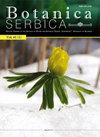The antioxidant response of Hedera helix leaves to seasonal temperature variations
IF 1.1
4区 生物学
Q4 PLANT SCIENCES
引用次数: 0
Abstract
Seasonal variations in the environment (e.g. of temperature and light intensity) can lead to the excess production of reactive oxygen species and oxidative stress, inducing changes in the permeability of the plant cell membrane and the structure and function of cellular molecules. To address these deleterious effects, plants activate various non-enzymatic and enzymatic antioxidants. This study seeks to detect the influence of seasonal variation in Hedera helix (ivy) leaves, collected in Banj brdo (Banja Luka, Republika Srpska, Bosnia and Herzegovina) between December 2017 and November 2018, on oxidative (hydrogen peroxide and malondialdehyde) and antioxidant (superoxide dismutase, catalase, Class III peroxidases, and phenolic compounds) parameters. During the winter-early spring months (a temperature range of 0.7 to 5.4?C), we detected an increase in the values of all the oxidative and antioxidant parameters, whereas during the spring, summer, and autumn months (a temperature range of 15 to 25?C), the values of most of these parameters fell. However, a peak in the parameter values was detected during June and July 2018, which might be attributable to the influence of the changes in both light intensity and temperature and to the effects of intensive shoot growth. Our results highlight the importance of the antioxidant protection system of H. helix for its acclimation to seasonal variations in the environment, especially temperature.黑德拉叶片对季节温度变化的抗氧化反应
环境的季节性变化(如温度和光照强度)可导致活性氧的过量产生和氧化应激,从而引起植物细胞膜通透性和细胞分子结构和功能的变化。为了解决这些有害影响,植物激活各种非酶和酶抗氧化剂。本研究旨在检测2017年12月至2018年11月期间在Banj brdo (Banja Luka,塞族共和国,波斯尼亚和黑塞哥维那)收集的Hedera helix(常春藤)叶子的季节变化对氧化(过氧化氢和丙二醛)和抗氧化(超氧化物歧化酶,过氧化氢酶,III类过氧化物酶和酚类化合物)参数的影响。在冬季至早春季节(0.7 ~ 5.4℃),氧化和抗氧化指标均呈上升趋势,而在春季、夏季和秋季(15 ~ 25℃),氧化和抗氧化指标均呈下降趋势。但在2018年6月和7月,这些参数值出现峰值,这可能是受光强和温度变化的影响以及新梢密集生长的影响。我们的研究结果强调了H. helix抗氧化保护系统对其适应环境季节性变化,特别是温度变化的重要性。
本文章由计算机程序翻译,如有差异,请以英文原文为准。
求助全文
约1分钟内获得全文
求助全文
来源期刊

Botanica Serbica
Agricultural and Biological Sciences-Plant Science
CiteScore
1.40
自引率
12.50%
发文量
17
审稿时长
34 weeks
期刊介绍:
Botanica Serbica publishes original research papers on all aspects of plant, fungal and microbial biology research including the disciplines of microbiology, mycology, lichenology, bryology, flora, vegetation, biogeography, systematics, taxonomy, plant biotechnology, plant cell biology, plant ecology, environmental plant biology, forestry, genomics, horticulture, limnology, metabolomics, molecular biology, proteomics, virology, plant conservation and protection, and wildlife and ecosystem management.
 求助内容:
求助内容: 应助结果提醒方式:
应助结果提醒方式:


